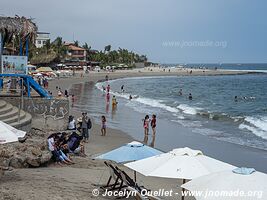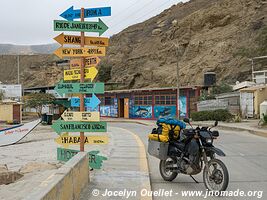Pacific Coast - part 1
The Pacific Coast of Northern Peru is a mix of beauty and horror. There are few nice villages and small towns with nice beaches, but the majority of the coast seems dedicated to oil and gas exploitation. The beaches can't compete on an international level; the water is not very clear, and its temperature reaches no more than 20 degrees in the warmest months of the year. Despite all this, some places are very popular with the locals and surfers.
Puntal Sal
Máncora
The small beach resort of Máncora is popular with the locals. The sandy beach is quite pretty, and the waves are known to many amateur surfers.
It is also a fishing village.
From Máncora to Talara
This stretch of the coast rarely see any tourist. At this time of the year (August), the sky is almost always grey, and the temperature hovers around 20 degrees. Therefore, it's a drive under a grey sky that awaits you, if you follow the coast, in addition to landscapes dulled by the presence of numerous drilling platforms, oil pumping stations, and even old pipelines along the roads.
Here, I found myself in front of a sad reality that can be still be seen too frequently in some poorer countries. The trash management is really basic, and only consists in piling the trash in an open pit in a specific place. I say a pit, but there is no pit, and it seems the place has been chosen at random.
The Pacific Coast of Peru is constantly swept by strong winds in the afternoon. You can see the effect of this; the plastic get blown away and gets stuck on shrubs around the dumping ground. It is easy to notice you are approaching such a dump one or two kilometres before reaching it.
Talara
Not many comments on this place, except to say it's a dirty and smelly town. Imagine that when you reach the town, a not so fresh fish smell overwhelm your smelling senses, thrashes are found all over the place, and absolutely everything seems to be in a bad shape.
From Talara to Paita
The Peruvian coast is a semi-desert. I am always impressed to discover a river and the life that it brings in its wake.
Around these rivers, there are always a few isolated houses, or small villages where people can engage in farming.
From Piura to Lambayeque
Another dump
Another open pit dump even more “impressive” than the first. How sad!
With time, the sun's UV rays cause aging of polymers of plastic bags and containers. They break down into small particles, and disperse themselves in the nature carried away by the wind.
Eventually, all this plastic finds its way into our food. The contamination is possible through many vectors such as the water we drink, or via meat from fish who consumed microparticles in the seas or lakes.
A desert with many faces
On a stretch of 50-100 kilometres, the desert has many different faces.














































































